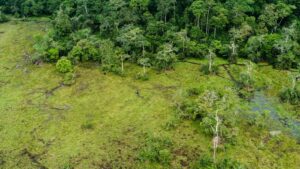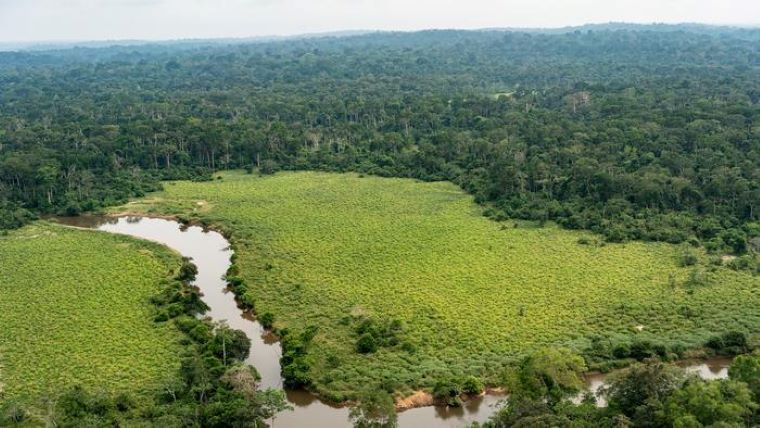A team of researchers from Harvard University has revealed a “treasure trove” of data on mysterious voids in the Congo Basin of west-central Africa that seemingly appear out of nowhere.
Dubbed “bais,” these treeless oases that seem to pop up randomly deep within the region’s dense tropical rainforests may serve a critical role for a broad range of animal species, including gorillas, forest buffalo, and elephants. The researchers behind this investigation even suspect these animals may play a role in creating bais, given their inordinate amount of time in and around them.
“There’s a great need to understand what’s happening with these bais because they’re so important to organisms we’re trying to conserve,” explained Harvard’s Evan Hockridge, a Griffin Graduate School of Arts and Sciences student in the lab of Andrew Davies, assistant professor in the Department of Organismic and Evolutionary Biology.
“Our goal is to understand how animals are interacting with these clearings,” Hockridge added. “Are they making them? How dependent are they on them? Are these clearings stable over time?”
Previous informal efforts to count these mysterious voids have estimated their total to be around 250. However, this latest effort says the number of sudden canopy gaps is over 2,000.
Analysis Unearths Tantalizing Clues about Congo’s Mysterious Voids
The team looked at more than 5,000 square miles of conserved forest in Odzala-Kokoua National Park, Republic of the Congo, where all of the bais seem to appear. This effort included a 2021 trip into the dense rainforest to collect geological, ecological, and topological data about these mysterious regions, including evidence that may reveal where they come from and their role in the broader tropical rainforest environment.
To gather as much data as possible, the team employed a customized remote-sensing protocol involving drone-based Light Detection and Ranging (Lidar) and complemented their findings with satellite data. According to the team’s lead researcher, this two-year-long expedition to unravel the bais mystery resulted in unprecedented amounts of critical information about this rarely studied phenomenon.
“This was a huge data collection effort, involving everything from drones to soil measurements to camera trapping to identification of plant species,” Hockridge explained.


As previously noted, the team found that the number of bais had been grossly underestimated. Over 2,000 such mysterious voids were spotted, dwarfing the previous informal estimate of around 250. They also discovered that the animals who frequent these regions had preferences. Foliage that attracted gorillas didn’t attract elephants, and vice versa.
Perhaps surprisingly, Hockridge says he didn’t set out to study the mysterious, treeless regions. Instead, the researcher says he was initially focused on understanding how Africa’s largest animals engineer their own ecosystems. However, he soon realized that these forest oases might hold the key to understanding that complex relationship, including the possibility that these creatures were creating bais for their own purposes.
“Animals are extremely attracted to these giant clearings in the middle of the forest, including many endangered animals like the Western lowland gorilla and the African forest elephant,” Hockridge said. “These keystone conservation priority species will spend enormous portions of their lives basically just moving between bais.”
The budding scientist says the first time he stumbled upon a treeless bais after traveling through the thick, dense rainforest canopy was “stunning.” Forest buffalo were seen lounging along the banks of a freshwater stream or munching on the area’s short grasses. Flocks of over a thousand African pigeons could also be seen gathering salt and other nutrients from the stream.
“It’s like something out of a picture book, but the picture book doesn’t exist,” Hockridge said.
Barely Scratching the Surface of Bais Mystery
In the press release announcing the study, the authors say that their work would not have been possible without the help of Gwili Gibbon, the head of research and monitoring at Odzala-Kokoua National Park. They also acknowledge the contributions of Sylvain Ngouma and Roger Ognangue, “eco monitors” at the national park who served as the Harvard team’s local experts in the area’s biology and botany.
“This work would have been impossible without them,” Hockridge said. “They’re the most quintessential partners in the work we do.”
Although the team gathered unprecedented amounts of data about the mysterious voids in the Congo that seem to appear out of nowhere, they believe it is only a matter of time before their research and future efforts unravel the role of these forest oases.
“This study helps us understand a little bit more about their functioning and the treasure trove of biodiversity they hold, which only inspires and excites us to keep exploring and discovering more of their secrets,” Davies said. “We are still just barely scratching the surface of what we know about them.”
The study “Spatial ecology, biodiversity, and abiotic determinants of Congo’s bai ecosystem” was published in Ecology.
Christopher Plain is a Science Fiction and Fantasy novelist and Head Science Writer at The Debrief. Follow and connect with him on X, learn about his books at plainfiction.com, or email him directly at christopher@thedebrief.org.

